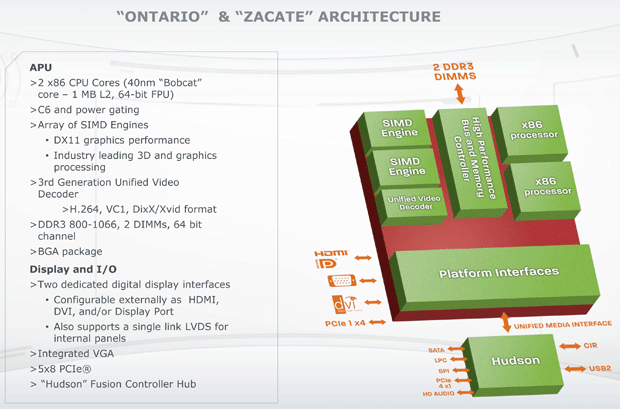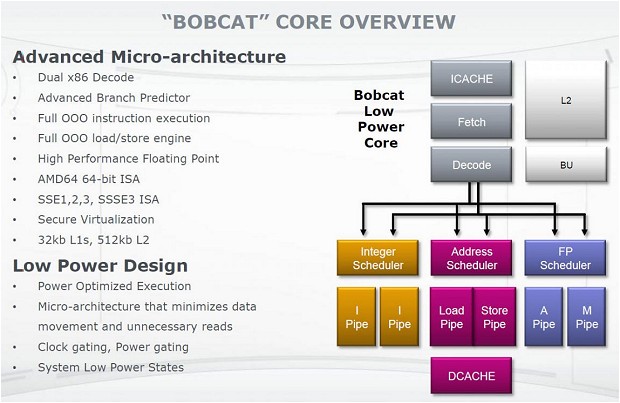Discovering AMD Fusion
The AMD Fusion platform combines Bobcat cores together with GPU cores to create Accelerated Processing Units (APUs). The Bobcat cores are a significant step ahead of Atom as they are out-of-order 64-bit cores.
In computer engineering, out-of-order execution (OoOE or OOE) is a standard used in most high-performance microprocessors to make use of instruction cycles that would otherwise be wasted by a certain type of costly delay. With this standard, the processor executes instructions in an order assigned by the availability of input data rather than by their original order in a program.


It's not just the Bobcat cores that are superior to Atom, so is the GPU. AMD has implemented an on-die DirectX 11 GPU, the Radeon HD 6310. Codenamed "Wrestler", the 40nm graphics core operates at 500MHz and is part of the E-350 (dual-core) and E-240 (single-core) processors. There is also a 280MHz version called the Radeon HD 6250 which is featured in the "Ontario" C-30 and C-50 processors.
It's interesting to note that the Radeon HD 6310 and HD 6250 both have the same configuration as the Radeon HD 5450 as well as the much older HD 4350 and HD 4550. The core consists of 80 SPUs, 8 TAUs (Texture Address Units) and 4 ROPs (Rasterization Operator Units). When compared to the Radeon HD 4290 of the current flagship 890GX desktop chipset, that's not bad. The Radeon HD 4290 boasts just 40 SPUs, 4 TAUs and 4 ROPs.

AMD has decided not to brand their first APUs, rather they are just featured under the Fusion banner. This means the E-series and C-series processors will be known as the AMD E-350, for example.
Whereas the Atom "Pineview" is paired with the NM10 Platform Controller Hub (PCH), the new AMD APUs also needed an additional chip to handle connectivity. Known as the Hudson Fusion Controller Hub (FCH), this 28mm2, 65nm chip provides support for features such as SATA, USB, Ethernet and audio.
There are several versions of the FCH (Fusion Controller Hub) designed for notebook, desktop and embedded platforms. The Asus E35M1-M Pro that we have here today features the Hudson-M1 controller. This version features just a single PCI Express x4 1.0 (2.5 GT/s) lane, six SATA 6Gb/s (AHCI 1.2) ports and fourteen USB 2.0 ports.